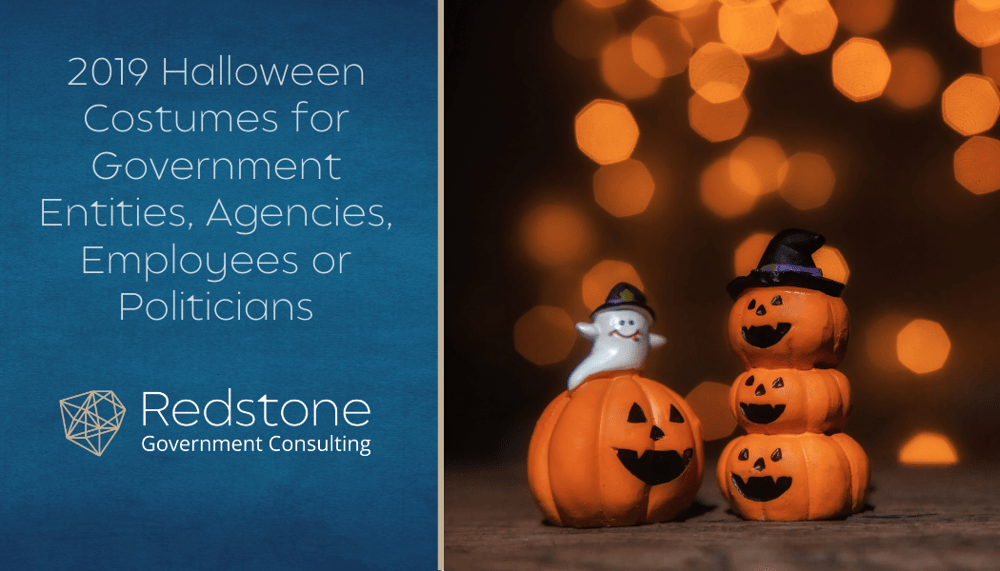
As we begin October 31st, we’ve invested heavily in researching all sources to identify the Halloween costumes which will most likely be used by Government entities (including Congress), agencies, and employees (or wannabe employees in the context of political candidates).

Whistle-blower: Trumps’ Accuser and Many Others Seeking an Audience and Protection. One of the most popular costumes is the whistle-blower, in large part because of its simplicity (a cheap whistle and actual or fabricated facts that sound good) and the fact that there are so many laws which now protect whistle-blowers from retaliation by the assumed-to-be-evil wrong-doers (subject of the whistle-blower’s allegations). There is almost nothing which protects the “target” from fabricated (or embellished) allegations as long as the whistle-blower believes in his or her allegations. No one would ever be a whistle-blower for anything but good intentions, void of any malicious motivations. It simply goes against human nature for anyone to be anything but a well-intentioned whistle-blower seeking “liberty and justice for all” while never seeking public attention, a means to promote a personal agenda to a receptive (perhaps biased) audience, and/or a chronic complainer taking advantage of a process which protects the whistle-blower--because all whistle-blowers are good people exposing bad people and bad behavior. The truth and nothing but the truth…maybe.

Invisible Man: Former Director of Defense Procurement. Earlier this year, the Director of Defense Pricing (DDP), Mr. Shay Assad, was quietly reassigned to an executive position with responsibilities and authorities which effectively moved him from a highly visible policy position to an almost invisible administrative position. As something of a ruse, the publicized reason for the reassignment was attributed to the fact that Mr. Assad never actually moved to Washington DC (his residence remained in the Boston area and he routinely commuted on official travel at taxpayer expense to/from Washington DC). At some point after his reassignment (and loss of any real policy responsibilities or national audience), Mr. Assad apparently retired. As with the original invisible man, Mr. Assad has again become visible--reappeared, in this case--making public statements about the true reasons for his reassignment; that his unfavorable statements directed at defense contractors were not well-received by his Pentagon Boss whose prior position was CEO of a large defense contractor. In interviews with the media, Mr. Assad (no longer concerned with a boss) maintains that defense contractors routinely overcharge the Government by withholding cost or pricing data during contract negotiations. Coincidentally, Mr. Assad’s assertions have now been confirmed (sort of) by news reporters who used a FOIA request to obtain a 2018 DCAA internal study which concluded that $95 billion in contract pricing actions involved contractor defective pricing resulting in overcharges of $990 million (approximately 1%).
Although the original invisible man has long since disappeared, the ex-Director of Defense Pricing will probably reappear as long as someone listens to and prints his allegations.

Herbert Hoover: The 2020 Presidential Candidates (Democrat Party). Mr. Hoover has long been dead and largely forgotten, but his image can be associated with the various presidential candidates who are competing amongst themselves to see who can offer the most in terms of Government benefits with absolutely no viable plan for funding. Perhaps obvious to everyone (including these candidates), the end result would be explosive growth to the national debt (now at $23 Trillion, of which $10 Trillion was added by the last President from the Democratic Party). Mr. Hoover comes to mind based upon his quote: “Blessed are the children, for they shall inherit the national debt”. Mr. Hoover also comes to mind as a way for these candidates to assume a false identity. Mr. Hoover’s statement came at a time when the US debt first surged as then, President Roosevelt, pushed federal spending as the solution for the Great Depression. However, Roosevelt, the original big spender, had a different take on the National Debt, stating that it was not a bad thing because it was nothing more than an “internal debt”; i.e. taxpayer debt owed to taxpayers (ignoring that the debt was spent for millions of persons who were not those holding the debt, or that the majority of the benefactors may not be taxpayers, or that a significant portion of the national debt might become foreign owned). Unfortunately, the idea of federal spending without regard to funding or long-term consequences has become an accepted practice (by both political parties) and there seems to be nothing but superficial concern for the children who will in fact inherit the unsustainable national debt.

In-Laws: DCAA (Defense Contract Audit Agency): DCAA is equivalent to one’s (stereotypical) in-laws based upon:
- DCAA auditors show up with little or no advance notification (or unannounced in the case of floor checks), uninvited and with no consideration of their impact on your normal tasks and responsibilities.
- DCAA auditors aren’t concerned with your schedules (work hours), only their work and non-work hours. If they normally work 7am to 3:30, set your alarm to be available at 7am. And even if you might have some free time to entertain/work with them on Fridays, anticipate that they will more likely just lay around on the couch because Friday is their flex-day off.
- If the only parking is on-street (e.g. inconvenient), expect them to request preferential parking spaces (such as your parking space in your garage)
- There are always more of them than you remembered or that you would expect, as if they added second cousins (e.g. auditors in training) in route to your house/facilities. DCAA can’t seem to audit without using ever-expanding teams, including one recent example where 15 auditors showed up at an entrance conference at the start of a business systems audit. The contractor has one compliance person and a large part of its Government contracts are classified (i.e. not within the purview of these 15 auditors). In another recent case, 8 auditors to audit a bid proposal valued at approximately $25 million (not all that significant in a world of trillion-dollar annual budgets).
- Like your unwanted in-laws, DCAA auditors seemingly stay forever, they take over your facilities, they want to roam without any limitations and unfettered access to your stuff (intranet, accounting records, employees).
- When DCAA finally finishes an audit, they may or may not leave without saying goodbye, and rarely without thanking you for your (involuntary) hospitality. But they will predictably leave you with less than you had before they arrived. The good news, DCAA, unlike your in-laws, will not take your food or drinks (gratuity issues), but if they do provide their own food or drink, they won’t share nor will they pick-up up after themselves; that goes against expectations that you are there to accommodate them.

Corporal Obvious (think Captain Obvious, but lower ranking): Inspector Generals and/or Government Accountability Office (IGs and/or GAO). The various IGs and the GAO have earned the right to wear the Corporal Obvious costume based upon their less-than insightful abilities to perform reviews which yield reports whose facts and conclusions are so obvious as to raise the question as to the relevance of the agency or agencies. Along the same lines, the recurring reports with facts and conclusions which almost never change. Some examples of reporting by “Corporal Obvious”:
- SIGAR (Special IG for Afghanistan) whose quarterly reports are almost identical in terms of cautionary statements regarding challenges in achieving long-term stability in Afghanistan (which has been known since the outset of US involvement). Similarly, SIGAR reports concerning trackability of funds and/or physical assets transferred to the national security forces of Afghanistan (we think). Brings up the quote from Wizard of Oz, “Toto, we are not in Kansas anymore”. If one thrives on predictability, that person should look forward to the next SIGAR quarterly report.
- IG reports on major weapon systems (cost growth and/or schedule slippage). Although these reports become more favorable as time progresses and a program matures, there has never been an IG report which stated that a program has achieved everything promised. Hence, the inevitable wording starting as “the Program has major technical challenges impacting funding and schedules, evolving to “The Program has improved, but challenges remain”. Thanks for reporting the obvious.
- IG reports on Government agencies and their compliance with laws and/or regulations. Examples include the annual reporting on agency estimates of Government overpayments, agency management and use of P-cards, and the occasional GAO report on an agency’s violation of the anti-deficiency act. For example, the GAO recently cited the IRS (Dept. of Treasury) for violating the anti-deficiency act because the IRS continued to process tax payments during a 5-week period when its normal appropriations had lapsed. Apparently, the IRS has special funding to cover tax refunds, but not to handle tax payments so the latter activity during a normal funding lapse was forbidden. And it did not matter that the Treasury attorneys had issued an opinion that there was not an anti-deficiency issue, because the GAO has the final say. From a taxpayer perspective, doesn’t the GAO have something better to do with its time and resources? Regarding P-cards’ use or misuse, an IG report noted that DOD had understated the annual numbers; specifically, DOD reported 47 violations, but the IG concluded that there were actually 1,043 violations…Oops! And the inaccurate reporting was the focus of the DOD-IG report while the underlying issue of P-Card misuse was secondary. Is there an issue of priorities? And, as in almost all cases of Government agencies failing to comply with laws and/or regulations, the noncompliant agency reaction: “we will do better next time”.
- IG reports which are not conclusive, typically identifying and reporting dollar amounts “at risk” for having been misspent. For example, multiple contracting officers whose contracting actions/decisions were not well documented, thus, the risk of billions in overpayments. Is there some reason why the IG can’t complete the review and actually determine amounts that were misspent? Obviously not (per Corporal Obvious).

Punching-Bag: Administrative Contracting Officers (ACOs) with DCMA (Defense Contract Management Agency). ACO’s have become the collective punching bag for the DoD-IG based upon a number of IG reports (2015-2019) which have evaluated ACO decisions to resolve issues as reported in DCAA audit reports. In some cases, these were slam-dunks because ACOs were in fact ignoring regulatory requirements for decisions within specified time-frames; however, in many cases, the underlying issue is that a DCAA audit report included conclusions and audit exceptions which were “out on a limb” with respect to the contractual requirements/regulations. For whatever reason(s), the DoD-IG is solely focused on ACO actions in contrast to any IG reviews or reports which focus on the validity of the underlying audit assumptions, assertions and conclusions. In other words, the ACOs are the punching bag, while DCAA is essentially watching from the sidelines and/or implicitly providing new punching bags. Examples include ACO resolution of DCAA reports on contractor compensation, contractor incurred costs and contractor business systems. In virtually all cases, the DOD-IG is assisted by DCAA in terms of how to interpret the underlying regulations applied to the specific issue(s) under review. One would assume that the DOD-IG would have the competency to perform the review without DCAA helping the IG conclude that DCMA failed to enforce regulations (as interpreted by DCAA).

The Great Halloween Pumpkin: Section 809 Acquisition Reform Committee. The Great Halloween Pumpkin is supposed to show itself on Halloween night; hence, Linus (from Charles Schultz Peanuts cartoons) has spent every Halloween night in the pumpkin patch awaiting the arrival of “The Great Pumpkin” (and everything good that it would bring). Linus has even convinced his friends of the pending arrival of The Great Pumpkin, in which case, one or more have also eagerly awaited this event. Although Linus remains steadfast in his belief, The Great Pumpkin has never appeared; leaving everyone but Linus to realize that The Great Pumpkin is a mythological character with great promise, but without any tangible results; sort of like the Section 809 Acquisition Reform Panel and virtually every acquisition reform group or initiative since acquisition reform was first introduced in 19___ (the year does not matter, just that we will continue to be disappointed as we await the next promise of acquisition reform).


 Mike Steen is a Emeritus Advisor with Redstone Government Consulting, Inc. and a specialist in complex compliance issues to include major contractor cost accounting & business system regulations, financial compliance, resolution of DCAA audit issues, Cost Accounting Standards application, litigation support, and claims preparation. Prior to joining Redstone Government Consulting, Mike served in a number of capacities with DCAA for over thirty years, and upon his retirement, he was one of the top seven senior executives with DCAA. Mike Served as a Regional Director for two DCAA regions, and during that time was responsible for audits of approximately $25B and 800 employees. In October 2001, he was selected for the Senior Executive Service and in 2006 he received the Presidential Rank Award. During Mike’s tenure with DCAA, he was involved in conducting or managing a variety of compliance audits, to include cost proposals, billing systems, Cost Accounting Standards, claims, defective pricing, and then-evolving programs such as restructuring, financial capability and agreed-upon procedures. He directly supported the government litigation team on significant contract disputes and has prepared and presented various lectures and seminars to DCAA staff and business community leaders. Since joining Redstone Government Consulting in June 2007, Mike has developed and presented training and seminars on Government Contracts Compliance to NCMA, Federal Publications Seminars and various clients. Mike also is a prolific contributor of written articles to government contracting publications, as well as to our own Government Insights Newsletter. Mike also serves as the director of our training service offerings, with responsibilities for preparing and developing course content as well as instructing our seminars to clients and general audiences throughout the U.S. Mike also serves as a faculty instructor for the Federal Publications Seminars organization. Education Mike has a BS Degree in Business Administration from Wichita State University. He is also a graduate of the DCAA Director’s Fellowship Program in Management, and has a Masters Degree in Administration from Central Michigan University. Mr. Steen also completed a number of OPM’s management and executive development courses.
Mike Steen is a Emeritus Advisor with Redstone Government Consulting, Inc. and a specialist in complex compliance issues to include major contractor cost accounting & business system regulations, financial compliance, resolution of DCAA audit issues, Cost Accounting Standards application, litigation support, and claims preparation. Prior to joining Redstone Government Consulting, Mike served in a number of capacities with DCAA for over thirty years, and upon his retirement, he was one of the top seven senior executives with DCAA. Mike Served as a Regional Director for two DCAA regions, and during that time was responsible for audits of approximately $25B and 800 employees. In October 2001, he was selected for the Senior Executive Service and in 2006 he received the Presidential Rank Award. During Mike’s tenure with DCAA, he was involved in conducting or managing a variety of compliance audits, to include cost proposals, billing systems, Cost Accounting Standards, claims, defective pricing, and then-evolving programs such as restructuring, financial capability and agreed-upon procedures. He directly supported the government litigation team on significant contract disputes and has prepared and presented various lectures and seminars to DCAA staff and business community leaders. Since joining Redstone Government Consulting in June 2007, Mike has developed and presented training and seminars on Government Contracts Compliance to NCMA, Federal Publications Seminars and various clients. Mike also is a prolific contributor of written articles to government contracting publications, as well as to our own Government Insights Newsletter. Mike also serves as the director of our training service offerings, with responsibilities for preparing and developing course content as well as instructing our seminars to clients and general audiences throughout the U.S. Mike also serves as a faculty instructor for the Federal Publications Seminars organization. Education Mike has a BS Degree in Business Administration from Wichita State University. He is also a graduate of the DCAA Director’s Fellowship Program in Management, and has a Masters Degree in Administration from Central Michigan University. Mr. Steen also completed a number of OPM’s management and executive development courses.